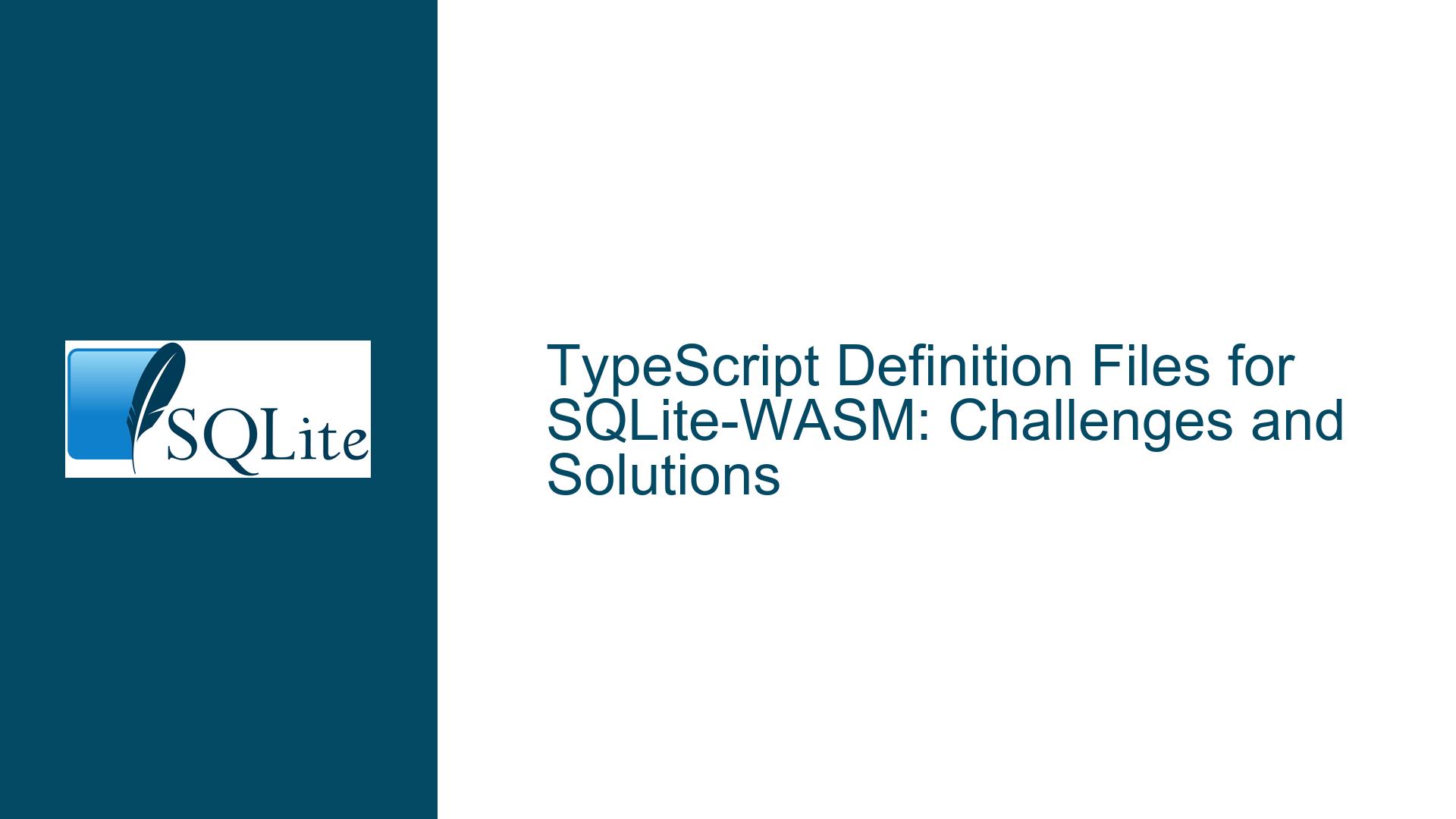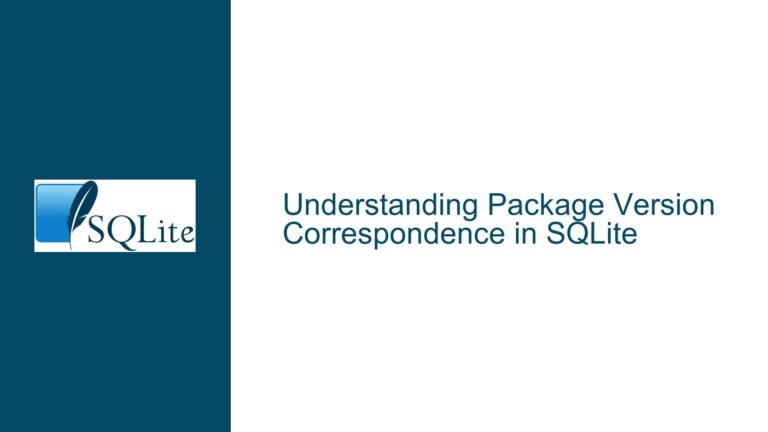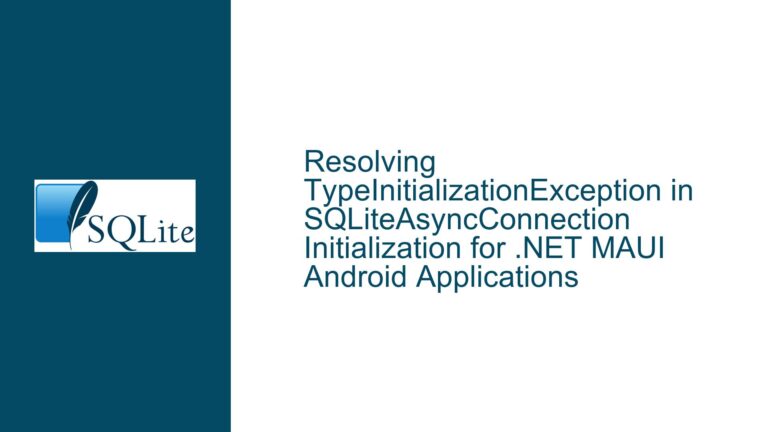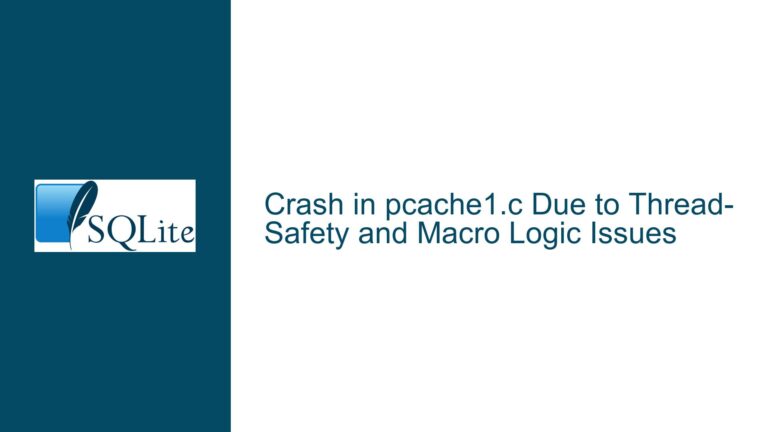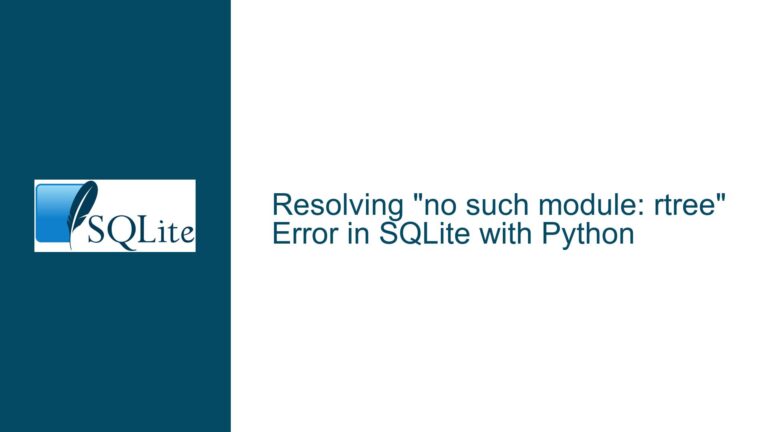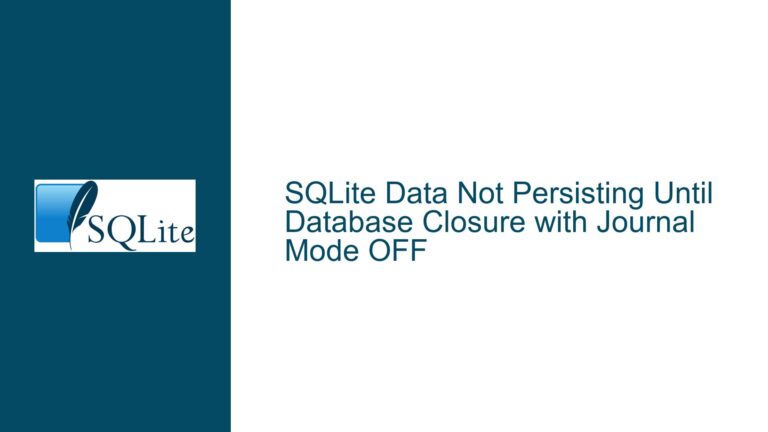TypeScript Definition Files for SQLite-WASM: Challenges and Solutions
Issue Overview: Lack of TypeScript Type Definitions in SQLite-WASM
The core issue revolves around the absence of TypeScript type definition files (.d.ts) for the SQLite-WASM library. TypeScript, being a statically typed superset of JavaScript, relies heavily on type definitions to provide developers with type safety, autocompletion, and improved tooling support. The SQLite-WASM library, which allows SQLite to run in web browsers via WebAssembly, currently does not include TypeScript type definitions as part of its core deliverables. This omission creates challenges for developers who prefer or require TypeScript for their projects.
The SQLite-WASM library exposes two primary APIs: the Object-Oriented (OO) API and the C-style API (capi). The OO API is more user-friendly and aligns well with JavaScript’s object-oriented nature, while the capi provides a lower-level interface that closely mirrors the traditional SQLite C API. Both APIs are extensive, with the capi being particularly complex due to its direct mapping to SQLite’s C functions. The lack of TypeScript definitions for these APIs means that developers must either manually define types or work without the benefits of TypeScript’s type system.
The absence of TypeScript definitions is not due to a lack of interest or recognition of their value. Instead, it stems from practical challenges. The SQLite-WASM project maintainers do not use TypeScript or tools that rely on type definitions, making it difficult for them to maintain accurate and up-to-date type definitions. Additionally, the sheer complexity and size of the SQLite-WASM APIs, especially the capi, make manual maintenance of type definitions a daunting task. This complexity is further compounded by the fact that SQLite-WASM is a port of SQLite to WebAssembly, which introduces additional layers of abstraction and potential discrepancies between the original C API and its JavaScript/WebAssembly counterpart.
Despite these challenges, there is a growing demand for TypeScript definitions within the SQLite-WASM community. Developers working on TypeScript projects often find themselves writing custom type definitions or relying on limited, community-generated definitions. This situation is suboptimal, as it leads to inconsistencies, potential errors, and a lack of standardization across projects. The need for a robust, maintainable solution to provide TypeScript definitions for SQLite-WASM is evident.
Possible Causes: Why TypeScript Definitions Are Missing in SQLite-WASM
The absence of TypeScript definitions in SQLite-WASM can be attributed to several factors, each of which contributes to the complexity of the issue. Understanding these causes is crucial for identifying potential solutions and workarounds.
Project Maintainers’ Tooling Preferences: The primary maintainers of the SQLite-WASM project do not use TypeScript or tools that rely on type definitions. This lack of firsthand experience with TypeScript makes it challenging for them to prioritize the creation and maintenance of type definitions. Without internal demand or expertise, the task of generating and maintaining TypeScript definitions falls to the community, which may lack the resources or authority to ensure consistency and accuracy.
Complexity of the SQLite-WASM APIs: The SQLite-WASM library exposes a wide range of APIs, with the capi being particularly complex. The capi is a direct port of SQLite’s C API, which includes numerous functions, structures, and macros. Translating this API into TypeScript definitions requires a deep understanding of both SQLite’s internals and TypeScript’s type system. The complexity is further increased by the need to handle differences between C and JavaScript, such as memory management and data types.
Dynamic Nature of JavaScript: JavaScript’s dynamic nature poses additional challenges for generating accurate TypeScript definitions. Unlike statically typed languages, JavaScript allows for flexible and dynamic behavior, which can be difficult to capture in TypeScript’s type system. This is especially true for APIs that rely on dynamic properties, callbacks, or runtime type checking. Ensuring that TypeScript definitions accurately reflect the behavior of the SQLite-WASM APIs requires careful consideration and testing.
Lack of Automated Tooling: Generating TypeScript definitions from a complex C API like SQLite’s is not a straightforward task. While there are tools available for generating TypeScript definitions from JavaScript code, these tools may not be well-suited for handling the intricacies of a C API ported to WebAssembly. The lack of automated tooling that can accurately generate TypeScript definitions from SQLite’s C API is a significant barrier to providing comprehensive type definitions for SQLite-WASM.
Resource Constraints: The SQLite-WASM project is maintained by a small team with limited resources. Prioritizing the creation and maintenance of TypeScript definitions may not be feasible given the team’s other responsibilities and the complexity of the task. This resource constraint means that the burden of providing TypeScript definitions often falls on the community, which may lack the coordination and expertise needed to produce high-quality, maintainable definitions.
Troubleshooting Steps, Solutions & Fixes: Addressing the TypeScript Definition Gap in SQLite-WASM
Addressing the lack of TypeScript definitions in SQLite-WASM requires a multi-faceted approach that combines community involvement, tooling improvements, and best practices for maintaining type definitions. Below are detailed steps and solutions to help bridge the gap and provide developers with the TypeScript support they need.
Community-Driven TypeScript Definitions: Given the SQLite-WASM maintainers’ limited resources and tooling preferences, the most viable solution is for the community to take the lead in creating and maintaining TypeScript definitions. This approach has been successful in other open-source projects, where community contributions have filled gaps in official support. Developers can collaborate on a shared repository for SQLite-WASM TypeScript definitions, ensuring that the definitions are comprehensive, accurate, and up-to-date.
Leveraging Existing Tools for TypeScript Definition Generation: While there is no one-size-fits-all tool for generating TypeScript definitions from a C API, developers can leverage existing tools and techniques to automate parts of the process. For example, tools like
dts-gencan be used to generate initial TypeScript definitions from JavaScript code, which can then be refined manually. Additionally, developers can use static analysis tools to extract type information from SQLite’s C source code and convert it into TypeScript definitions. Although this approach requires significant effort, it can help reduce the manual workload and improve the accuracy of the definitions.Modular TypeScript Definitions: Given the complexity of the SQLite-WASM APIs, it may be beneficial to adopt a modular approach to TypeScript definitions. Instead of attempting to define all APIs in a single file, developers can create separate definition files for different parts of the API, such as the OO API and the capi. This modular approach makes it easier to manage and update the definitions, as changes to one part of the API do not require modifications to the entire definition set. Additionally, modular definitions can be more easily shared and reused across projects.
TypeScript Definition Best Practices: To ensure that the TypeScript definitions are maintainable and accurate, developers should follow best practices for creating and managing type definitions. This includes using TypeScript’s advanced type features, such as conditional types and mapped types, to accurately represent the behavior of the SQLite-WASM APIs. Additionally, developers should document the definitions thoroughly, providing examples and explanations for complex types and functions. Regular testing and validation of the definitions against the actual SQLite-WASM codebase can help catch errors and inconsistencies early.
Integration with the SQLite-WASM NPM Distribution: The SQLite-WASM project maintains a separate NPM distribution, which is a more natural fit for TypeScript definitions. Developers can work on integrating TypeScript definitions into this distribution, ensuring that they are included as part of the package. This integration would make it easier for TypeScript users to access and use the definitions, as they would be automatically installed alongside the SQLite-WASM library. The NPM distribution can also serve as a central hub for community contributions, with maintainers reviewing and merging pull requests to keep the definitions up-to-date.
Collaboration with the SQLite-WASM Maintainers: While the SQLite-WASM maintainers may not use TypeScript themselves, they can still play a crucial role in supporting TypeScript definitions. By providing guidance, reviewing community contributions, and incorporating TypeScript definitions into the project’s documentation, the maintainers can help ensure that the definitions are accurate and aligned with the project’s goals. Additionally, the maintainers can facilitate communication between the TypeScript community and the core SQLite-WASM team, helping to address any technical challenges or discrepancies that arise.
Long-Term Maintenance Strategy: To ensure the long-term viability of TypeScript definitions for SQLite-WASM, developers should establish a clear maintenance strategy. This strategy should include regular updates to the definitions to reflect changes in the SQLite-WASM API, as well as a process for handling bug reports and feature requests. By treating the TypeScript definitions as a first-class citizen within the SQLite-WASM ecosystem, developers can ensure that they remain a valuable resource for the community.
In conclusion, while the lack of TypeScript definitions in SQLite-WASM presents significant challenges, there are several viable solutions and strategies for addressing the issue. By leveraging community contributions, improving tooling, and following best practices, developers can create and maintain high-quality TypeScript definitions that enhance the usability of SQLite-WASM in TypeScript projects. With the right approach, the SQLite-WASM community can bridge the gap and provide the TypeScript support that developers need.
